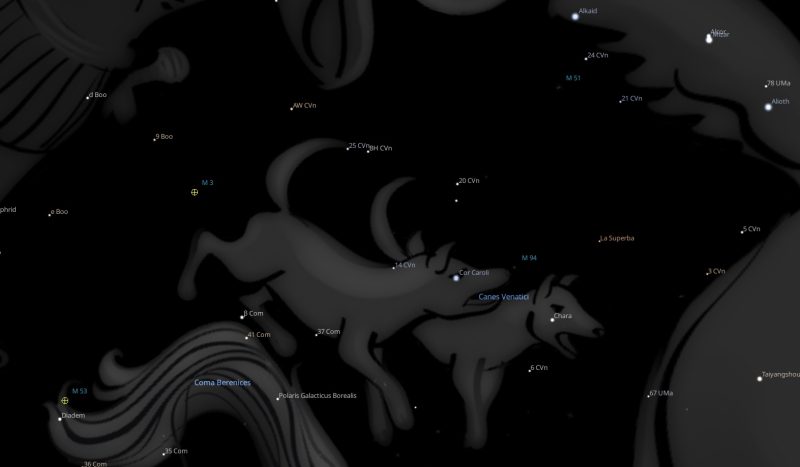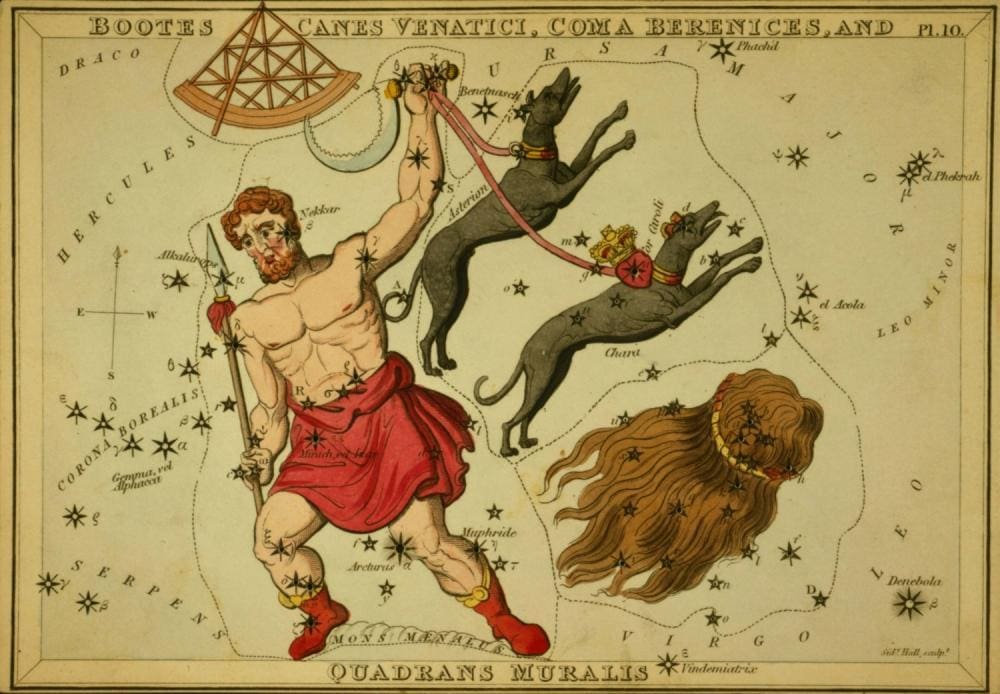FIXED STARS: Major Stars | 1000+ Stars | Constellations | About
Constellation Canes Venatici, the Hunting Dogs, is a northern constellation bordering Boötes, Ursa Major and Coma Berenices. It was introduced by Johannes Hevelius in 1690 and remains one of the 88 modern constellations. Canes Venatici spans 25 degrees of the zodiac in the Signs of Virgo and Libra.Canes Venatici Constellation Stars
| 2000 | 2050 | Star | Name | Sp. Class | Mag. | Orb |
|---|---|---|---|---|---|---|
| 07♍50 | 08♍33 | 5 CVn | Xiang | G7 | 4.77 | 1°00′ |
| 17♍07 | 17♍49 | Y CVn | La Superba | C7 | 5.42 | 1°00′ |
| 17♍42 | 18♍24 | β CVn | Chara | G0 | 4.24 | 1°20′ |
| 24♍34 | 25♍16 | α CVn | Cor Caroli | A0 | 2.81 | 2°00′ |
| 25♍07 | 25♍50 | M51 | Copula | 8.40 | 1°00′ |
β CVn is officially named Chara, but astrologers call it Asterion.
Canes Venatici Astrology
Robson
History. Formed by Hevelius in 1690. They are represented by two greyhounds, the northern one named Asterion, and the southern Chara, held in leash by Boötes and assisting in his pursuit of the Bear.
Influence. This constellation gives a love of hunting and a penetrating mind, making those born under it faithful, keen, clever and fond of speculation. [1]
Noonan
In ancient times the Big Bear was more extensive than modern Ursa Major, containing the stars of the constellations Canes Venativi (CVn), Lynx (Lyn), and Leo Minor (LMi).
The unfigured stars beneath the tail of the Big Bear in what is today Canes Venatici have the nature of the Moon and Venus. They can be quite beneficial as regards to the affairs of nations and kings.
The star Chara has a most beneficial reputation as regards the heads of state. It was said to have shown with particular brilliance when Charles II returned to London on May 29, 1660. [2]
Allen
Canes Venatici, the Hunting Dogs… lying between Boötes and Ursa Major. Ptolemy entered their stars among the ἀμόρφοτοι of the latter constellation, and the modern forms first appear in the Prodromus of their inventor Hevelius. The more northern one is Asterion, Starry, from the little stars marking the body; and the other, which contains the two brightest stars, is Chara, as Dear to the heart of her master. Flamsteed followed in the use of these names, and the Hounds are now well established in the recognition of astronomers, as is the case with most of the stellar creations of Hevelius, which were generally placed where needed.
Proctor, in his attempt to simplify constellation nomenclature, called them Catuli, the Puppies; but the usual illustration is of two Greyhounds held by a leash in the hand of Boötes, ready for pursuit of the Bear around the pole; their inventor thus reviving the idea that Boötes was a hunter.
Hevelius counted 23 stars here Argelander, 54; and Heis, 88.
The Chinese designated three stars in or near the head of Asterion as San Kung, the Three Honorary Guardians of the Heir Apparent. [3]
References
- Fixed Stars and Constellations in Astrology, Vivian E. Robson, 1923, p.34.
- Fixed Stars and Judicial Astrology, George Noonan, 1990, p.7.
- Star Names: Their Lore and Meaning, Richard H. Allen, 1889, p.114-117.
[wp_ad_camp_3]

